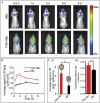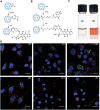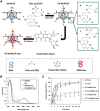Genetically Engineered Viral Vectors and Organic-Based Non-Viral Nanocarriers for Drug Delivery Applications
- PMID: 35916145
- PMCID: PMC11481035
- DOI: 10.1002/adhm.202201583
Genetically Engineered Viral Vectors and Organic-Based Non-Viral Nanocarriers for Drug Delivery Applications
Abstract
Conventional drug delivery systems are challenged by concerns related to systemic toxicity, repetitive doses, drug concentrations fluctuation, and adverse effects. Various drug delivery systems are developed to overcome these limitations. Nanomaterials are employed in a variety of biomedical applications such as therapeutics delivery, cancer therapy, and tissue engineering. Physiochemical nanoparticle assembly techniques involve the application of solvents and potentially harmful chemicals, commonly at high temperatures. Genetically engineered organisms have the potential to be used as promising candidates for greener, efficient, and more adaptable platforms for the synthesis and assembly of nanomaterials. Genetically engineered carriers are precisely designed and constructed in shape and size, enabling precise control over drug attachment sites. The high accuracy of these novel advanced materials, biocompatibility, and stimuli-responsiveness, elucidate their emerging application in controlled drug delivery. The current article represents the research progress in developing various genetically engineered carriers. Organic-based nanoparticles including cellulose, collagen, silk-like polymers, elastin-like protein, silk-elastin-like protein, and inorganic-based nanoparticles are discussed in detail. Afterward, viral-based carriers are classified, and their potential for targeted therapeutics delivery is highlighted. Finally, the challenges and prospects of these delivery systems are concluded.
Keywords: abiotic nanomaterials; genetically manipulation; nanoparticles; non-viral vectors; surface modifications.
© 2022 The Authors. Advanced Healthcare Materials published by Wiley-VCH GmbH.
Conflict of interest statement
The authors declare no conflict of interest.
Figures


















Similar articles
-
Silk-elastin-like protein biomaterials for the controlled delivery of therapeutics.Expert Opin Drug Deliv. 2015 May;12(5):779-91. doi: 10.1517/17425247.2015.989830. Epub 2014 Dec 5. Expert Opin Drug Deliv. 2015. PMID: 25476201 Free PMC article. Review.
-
Genetically engineered nanocarriers for drug delivery.Int J Nanomedicine. 2014 Mar 26;9:1617-26. doi: 10.2147/IJN.S53886. eCollection 2014. Int J Nanomedicine. 2014. PMID: 24741309 Free PMC article. Review.
-
Bioengineered elastin- and silk-biomaterials for drug and gene delivery.Adv Drug Deliv Rev. 2020;160:186-198. doi: 10.1016/j.addr.2020.10.008. Epub 2020 Oct 17. Adv Drug Deliv Rev. 2020. PMID: 33080258 Free PMC article.
-
Elastin-Like Recombinamers As Smart Drug Delivery Systems.Curr Drug Targets. 2018 Feb 19;19(4):360-379. doi: 10.2174/1389450117666160201114617. Curr Drug Targets. 2018. PMID: 26844559 Review.
-
Genetically Engineered Elastin-based Biomaterials for Biomedical Applications.Curr Med Chem. 2019;26(40):7117-7146. doi: 10.2174/0929867325666180508094637. Curr Med Chem. 2019. PMID: 29737250 Review.
Cited by
-
Combination therapy based on dual-target biomimetic nano-delivery system for overcoming cisplatin resistance in hepatocellular carcinoma.J Nanobiotechnology. 2023 Mar 14;21(1):89. doi: 10.1186/s12951-023-01840-3. J Nanobiotechnology. 2023. PMID: 36918874 Free PMC article.
-
Virus-Based Biological Systems as Next-Generation Carriers for the Therapy of Central Nervous System Diseases.Pharmaceutics. 2023 Jul 11;15(7):1931. doi: 10.3390/pharmaceutics15071931. Pharmaceutics. 2023. PMID: 37514117 Free PMC article. Review.
-
Synthesis and characterization of poly (β-amino ester) polyplex nanocarrier with high encapsulation and uptake efficiency: impact of extracellular conditions.Nanomedicine (Lond). 2025 Jan;20(2):125-139. doi: 10.1080/17435889.2024.2440307. Epub 2024 Dec 16. Nanomedicine (Lond). 2025. PMID: 39676537
-
Overcoming Solubility Challenges: Self-emulsifying Systems for Enhancing the Delivery of Poorly Water-Soluble Antiviral Drugs.Pharm Nanotechnol. 2025;13(1):117-132. doi: 10.2174/0122117385280541231130055458. Pharm Nanotechnol. 2025. PMID: 38192138 Review.
-
Bioengineered nanotechnology for nucleic acid delivery.J Control Release. 2023 Dec;364:124-141. doi: 10.1016/j.jconrel.2023.10.034. Epub 2023 Oct 27. J Control Release. 2023. PMID: 37879440 Free PMC article. Review.
References
-
- Chamundeeswari M., Jeslin J. G., Verma M. L., Environ. Chem. Lett. 2018, 17, 849.
-
- Tabasi H., Babaei M., Abnous K., Taghdisi S. M., Saljooghi A. S., Ramezani M., Alibolandi M., J. Nanostruct. Chem. 2021, 11, 501.
Publication types
MeSH terms
Substances
LinkOut - more resources
Full Text Sources

